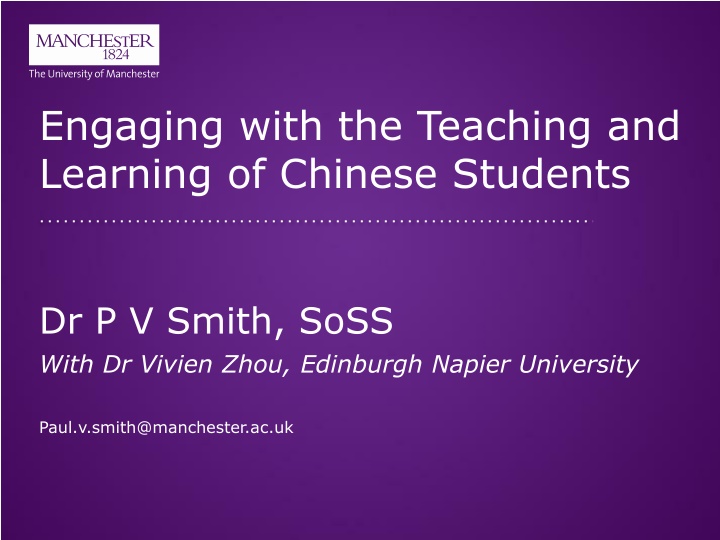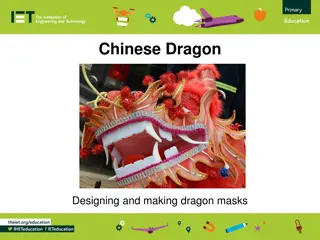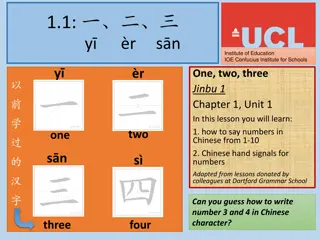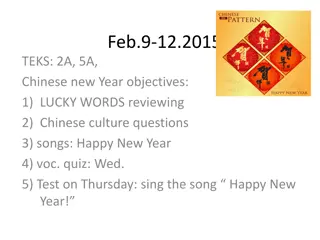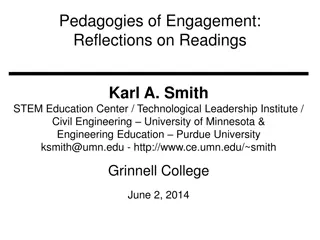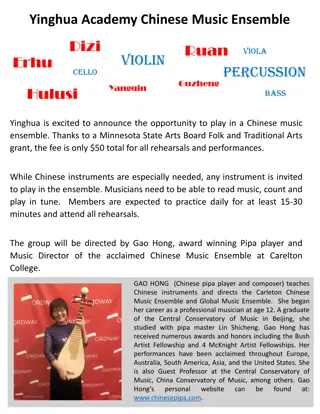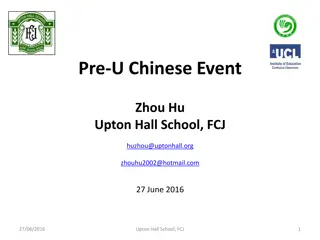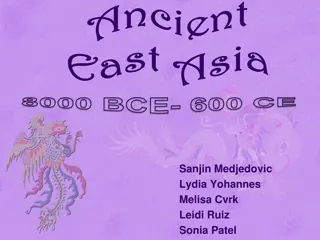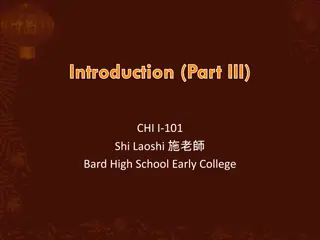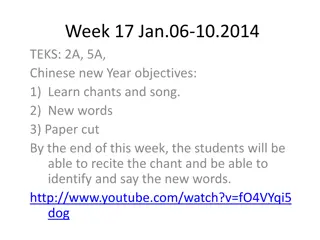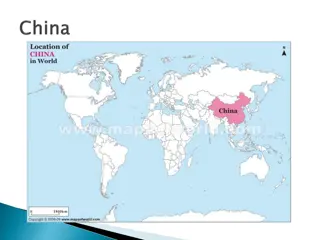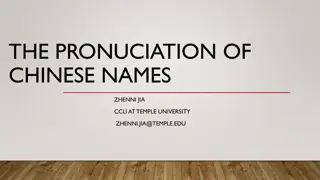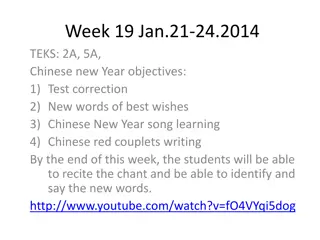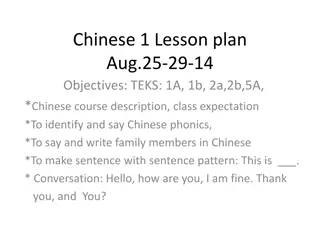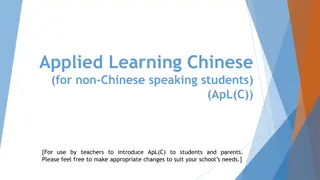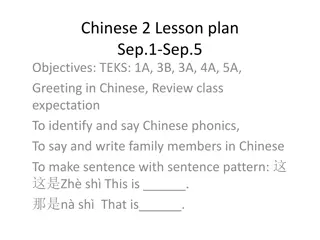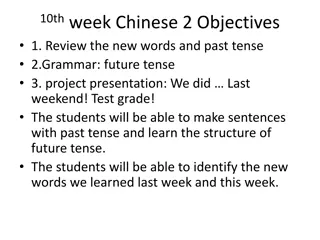Engaging with the Teaching and Learning of Chinese Students by Dr. P.V. Smith & Dr. Vivien Zhou
Exploring the challenges and nuances of teaching Chinese students in a UK higher education setting, this study delves into academic culture, language proficiency, support strategies, and more. Through innovative research methods like focus groups and interviews, the researchers gained valuable insights for enhancing educational practices and fostering cultural understanding.
Download Presentation

Please find below an Image/Link to download the presentation.
The content on the website is provided AS IS for your information and personal use only. It may not be sold, licensed, or shared on other websites without obtaining consent from the author.If you encounter any issues during the download, it is possible that the publisher has removed the file from their server.
You are allowed to download the files provided on this website for personal or commercial use, subject to the condition that they are used lawfully. All files are the property of their respective owners.
The content on the website is provided AS IS for your information and personal use only. It may not be sold, licensed, or shared on other websites without obtaining consent from the author.
E N D
Presentation Transcript
Engaging with the Teaching and Learning of Chinese Students Dr P V Smith, SoSS With Dr Vivien Zhou, Edinburgh Napier University Paul.v.smith@manchester.ac.uk
Heading 2007: doctoral candidates in then School of Education under Dr Richard Fay (Inter-cultural communication) Smith, P. V. & X. Zhou (2009) The Dissonance between Insider and Outside Perspectives of the Chinese Problem : Implications for one of the UK s largest undergraduate programmes in Coverdale-Jones & Rastall
Today What the problem was Methodological matters The paper and its findings New reflections and conceptual extensions Some teaching and learning recommendations Questions and comments
The Chinese Problem Academic culture Language proficiency Difference and diversity Making a difference How best to support certain student profiles Not so much retention or the student experience But how the Chinese approach to their studies cohered with notions of a UK higher education Also a problem inasmuch as it gave us the opportunity to apply our own methods to conducting an enquiry: Acculturation (Vivien); Academic Literacies (Paul) And they cause no more problems than any other students So a problem with no particular driver to change it
Methods Focus groups with small numbers of mainland Chinese students, revisiting themes over a short period of time Final round of focus groups conducted in parallel, in English and Mandarin Interviews (all in English) with local academic and support staff Later, Vivien interacted with the students in their halls (in Mandarin)
The Research Dyad Allowed us to compare prior perceptions Presumed different levels and layers of culture Both researchers were insider and outsider in respect to particular understandings of culture Led to a before and after comparative methodology, which allowed us to re-evaluate our prior views
A priori Paul Hard-working, committed, respectful Perhaps not academically curious ; instrumental purposes for learning Passive, not dynamic in class Highly numerate but less successful in literate or qualitative subjects Enclaves, and atrophy of English Seemed to be a problem that could be left alone Vivien Instrumental: degree choice for the Chinese job market, not for personal interests Wish to expand personal horizons in terms of language and personal development Seek information through word of mouth, not through official channels
Findings with students Additional language barrier through instruction by fellow NNSs of English No disciplinary basis for success in Philosophy, Sociology, Anthropology Academic writing: lack of knowledge, of opportunities for practice, of guidance, of feedback Essays: dispassionate argument and logic required; rather than life experiences, association, analogy, and imagination i.e., a viewpoint Plagiarism: easy to understand, difficult to avoid ; it relies not just on language skills, but also on originality Pastoral support: used to one person providing support on both academic and pastoral issues; here, they found highly specialised services Independent learning culture: from am I doing it right? to it s up to you and why don t they just tell you? Relied a lot more on lectures than on independent reading in preparation for writing
Findings with staff Chinese learners can be highly competent where there are right and wrong answers But anything you tell them is the truth All questions approaches as closed questions : can outline but not evaluate Hence: biased academic competence Plagiarism: the assignment is an opportunity for demonstrating the best answer, rather than their own knowledge [relates to Confucianism]; reflecting back without assimilation or dispute It is for students coming here to adapt, rather than for the system to change They might need to change the way they think but this goes beyond technical skills such as essay writing and language an epistemic or a practical requirement?
Summary of the research Chinese learners no less aware than the staff of perceptions of them, and in agreement with issues that could be addressed But a difference between more guidance (students) and changing the way they think (staff) Another tension between the willingness to consume packaged knowledge, but not being able to fully act as a consumer of services The Chinese learners did not come and consume , but waited to be educated and fostered suggests overt influence from prior models of education experienced Also begs the question: to what extent is prior education preparing them for life at a UK university?
What came next Recommendations? All right in theory, implausible in practice But the problem hadn t gone away, and was exacerbated by conducting the research Experiment possible in a local site
Study skills Academic socialisation Academic literacies After Lea & Street (1998)
Some applications to a study skills course Small groups (N = 16) Essay Draft, then final version Plagiarism amnesty at draft stage Individual feedback opportunities in writing and in person Feedback provided on hard copy at draft stage i.e. on document, something that can be manipulated in interaction Series of sessions leading up to draft submission Including plagiarism, essay writing and marking, library research Students can choose or adapt suggested essay titles
This applies to all students; what parts of the design work for Chinese learners specifically? Gives them the chance to make mistakes with little risk Draft stage helps avoid loss of face through poor performance in final version Provides a transitional phase in the learning process in dealing with plagiarism (Edwards & Ran 2009) Provides logical sites for close feedback Encourages personal interaction with tutor over a period of time, giving (at least temporarily) close, personal tutoring Show as much as tell better at making explicit (Edwards & Ran ibid.) Helps to demonstrate and scaffold their own processes for future efforts Addresses areas of perceived weakness in stages
Remaining possibilities for tweaking Essay titles: most students do not react well to having too much responsibility for setting their own topics; they want to make it expository (easy) rather than analytical (hard) So Make students confront the disciplinary assumptions Make them carry out a higher standard of reading through reducing the relevance of Google-search material More overtly address this in the library and research session Focus on argument / analysis
Suggestions Make it clear where the work is exploratory, i.e. where there can be no right or wrong answers; this can build confidence in contributing in class, etc. Autonomous learning can be seen as uncaring (Edwards & Ran 2009); but autonomousdoesn t need to mean unsupported Harness the employability agenda to show how analysis, etc. can contribute to strong decision making Bear in mind Face and that this can manifest in classroom settings Find topics and settings where it is easier for students to originate and express an opinion (e.g. a current affairs story that can also be approached from a variety of technical or disciplinary perspectives) Where possible, make the assessment personal; link tasks to possible selves (Stevenson 2012) Small group work with mixed groups, making students work together
Conclusions Problems can be conceived of locally, ergo local solutions are better Is there a small cultural reason or solution, before recourse to the big culture ? A lot of the problems and characteristics described are not exclusive to Chinese students So think of what works for students in this setting , and you may go some way to solving them for Chinese students as well Many of the solutions suggested by Academic Literacies, acculturation models, or the educational literature on Chinese learners require time and care with students pressure on this in universities
References Edwards, V. & A. Ran (2009) Building on Experience: Meeting the Needs of Chinese Students in British Higher Education In Coverdale-Jones, T. & P. Rastall (eds.) Internationalising the University: The Chinese Context Basingstoke: Palgrave Lea, M. & B. V. Street (1998) Student Writing in Higher Education: An Academic Literacies Approach Studies in Higher Education, 23 (2), pp. 157-172 Smith & Zhou (2009) in Internationalising the University: The Chinese Context Stevenson, J. (2012) An exploration of the link between Minority Ethnic and White students degree attainment and views of their future Possible Selves Higher Education Studies, 2 (4), pp. 103-113
